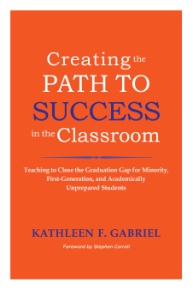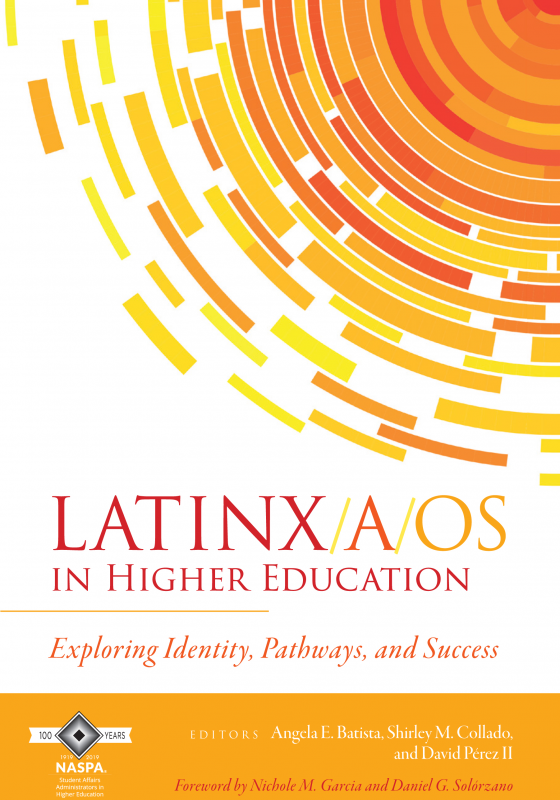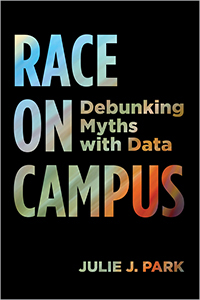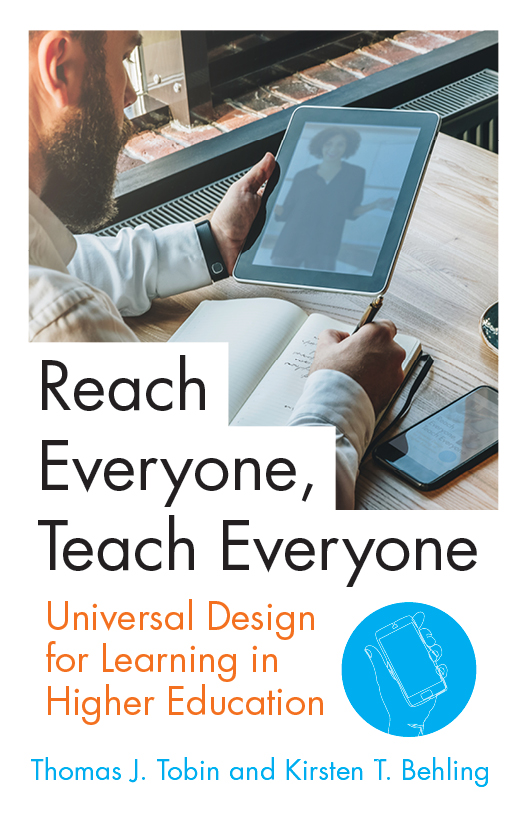
4 Selected Items
Select an item by clicking its checkbox
Creating the Path to Success in the Classroom: Teaching to Close the Graduation Gap for Minority, First-Generation, and Academically Unprepared Students
Additional Info:
Click Here for Book Review
This is a book for all faculty who are concerned with promoting the persistence of all students whom they teach.
Most recognize that faculty play a major role in student retention and success because they typically have more direct contact with students than others on campus. However, little attention has ...
Click Here for Book Review
This is a book for all faculty who are concerned with promoting the persistence of all students whom they teach.
Most recognize that faculty play a major role in student retention and success because they typically have more direct contact with students than others on campus. However, little attention has ...
Additional Info:
Click Here for Book Review
This is a book for all faculty who are concerned with promoting the persistence of all students whom they teach.
Most recognize that faculty play a major role in student retention and success because they typically have more direct contact with students than others on campus. However, little attention has been paid to role of the faculty in this specific mission or to the corresponding characteristics of teaching, teacher-student interactions, and connection to student affairs activities that lead to students’ long-term engagement, to their academic success, and ultimately to graduation.
At a time when the numbers of underrepresented students – working adults, minority, first-generation, low-income, and international students – is increasing, this book, a companion to her earlier Teaching Underprepared Students, addresses that lack of specific guidance by providing faculty with additional evidence-based instructional practices geared toward reaching all the students in their classrooms, including those from groups that traditionally have been the least successful, while maintaining high standards and expectations.
Recognizing that there are no easy answers, Kathleen Gabriel offers faculty ideas that can be incorporated in, or modified to align with, faculty’s existing teaching methods. She covers topics such as creating a positive and inclusive course climate, fostering a community of learners, increasing engagement and students’ interactions, activating connections with culturally relevant material, reinforcing self-efficacy with growth mindset and mental toughness techniques, improving lectures by building in meaningful educational activities, designing reading and writing assignments for stimulating deep learning and critical thinking, and making grade and assessment choices that can promote learning. (From the Publisher)
Table Of Content:
Foreword by Stephen Carroll
Ch 1. Retention, Persistence, and Success: Clarifying the Challenge
Ch 2. Class Climate: Widening the Circle for a Diverse Student Body
Ch 3. The First Month of the Semester: Engage, Connect, and Commit
Ch 4. Motivation and Attitudes: Impact of Mindsets and Mental Toughness Attributes
Ch 5. Interactive Lectures: Using Meaningful Educational Activities
Ch 6. Reading Assignments and Class Discussions: Stimulate Deeper Learning
Ch 7. Writing Assignments: Promote Critical Thinking and Writing
Ch 8. Resilience, Habits, and Persistence: Hold Fast and See it Through
Epilogue
Appendices
References
About the Author
Index
Click Here for Book Review
This is a book for all faculty who are concerned with promoting the persistence of all students whom they teach.
Most recognize that faculty play a major role in student retention and success because they typically have more direct contact with students than others on campus. However, little attention has been paid to role of the faculty in this specific mission or to the corresponding characteristics of teaching, teacher-student interactions, and connection to student affairs activities that lead to students’ long-term engagement, to their academic success, and ultimately to graduation.
At a time when the numbers of underrepresented students – working adults, minority, first-generation, low-income, and international students – is increasing, this book, a companion to her earlier Teaching Underprepared Students, addresses that lack of specific guidance by providing faculty with additional evidence-based instructional practices geared toward reaching all the students in their classrooms, including those from groups that traditionally have been the least successful, while maintaining high standards and expectations.
Recognizing that there are no easy answers, Kathleen Gabriel offers faculty ideas that can be incorporated in, or modified to align with, faculty’s existing teaching methods. She covers topics such as creating a positive and inclusive course climate, fostering a community of learners, increasing engagement and students’ interactions, activating connections with culturally relevant material, reinforcing self-efficacy with growth mindset and mental toughness techniques, improving lectures by building in meaningful educational activities, designing reading and writing assignments for stimulating deep learning and critical thinking, and making grade and assessment choices that can promote learning. (From the Publisher)
Table Of Content:
Foreword by Stephen Carroll
Ch 1. Retention, Persistence, and Success: Clarifying the Challenge
Ch 2. Class Climate: Widening the Circle for a Diverse Student Body
Ch 3. The First Month of the Semester: Engage, Connect, and Commit
Ch 4. Motivation and Attitudes: Impact of Mindsets and Mental Toughness Attributes
Ch 5. Interactive Lectures: Using Meaningful Educational Activities
Ch 6. Reading Assignments and Class Discussions: Stimulate Deeper Learning
Ch 7. Writing Assignments: Promote Critical Thinking and Writing
Ch 8. Resilience, Habits, and Persistence: Hold Fast and See it Through
Epilogue
Appendices
References
About the Author
Index

Latinx/a/os in Higher Education: Exploring Identity, Pathways, and Success
Additional Info:
The Latinx/a/o population is the largest and fastest-growing ethnic group in the United States, yet higher education attainment for this community is among the lowest. Latinx/a/os in Higher Education: Exploring Identity, Pathways, and Success addresses topics relevant to the experience of Latinx/a/o students and professionals and illustrates key elements that should be considered in the development of varied pathways to their success.
The Latinx/a/o population is the largest and fastest-growing ethnic group in the United States, yet higher education attainment for this community is among the lowest. Latinx/a/os in Higher Education: Exploring Identity, Pathways, and Success addresses topics relevant to the experience of Latinx/a/o students and professionals and illustrates key elements that should be considered in the development of varied pathways to their success.
Additional Info:
The Latinx/a/o population is the largest and fastest-growing ethnic group in the United States, yet higher education attainment for this community is among the lowest. Latinx/a/os in Higher Education: Exploring Identity, Pathways, and Success addresses topics relevant to the experience of Latinx/a/o students and professionals and illustrates key elements that should be considered in the development of varied pathways to their success.
Organized in five sections, this edited collection explores a number of critical topics, including:
-The current Latinx/a/o enrollment and success landscape
-Closing the attainment gap for Latinx/a/o students
-Advocacy and policymaking, with in-depth discussion of legislative policies and institutional practices related to undocumented students -Identity, cultural values and norms, gender, and sexuality in the Latinx/a/o community
-Advancing an anti-deficit achievement framework
-Developing pathways to access and success for Latinx/a/o students, particularly the role of community colleges and honors programs
As the Latinx/a/o population continues to grow rapidly, the need to develop promising pathways within success-oriented environments for Latinx/a/o students and professionals in higher education is now more important than ever. This indispensable publication will inform and guide student affairs and higher education in advancing the conditions necessary for Latinx/a/o students, faculty, and professionals to thrive. (From the Publisher)
Table Of Content:
FORWORD
Nichole M. Garcia and Daniel G. Solórzano
INTRODUCTION
Angela E. Batista, Shirley M. Collado, and David Pérez II
PART 1: CURRENT STATUS OF LATINX/A/OS IN AMERICAN HIGHER EDUCATION
Ch 1. The Current Latinx/a/o Landscape of Enrollment and Success in Higher Education - Sylvia Hurtado, Joseph Ramirez, and Katherine Cho
Ch 2. Policy Actors and Public Policy in Higher Education: Developing a National Organaizational Infrrastructure for Latina/o Postsecondary Advocacy - Magdalena Martinez and Melissa L. Freeman
Ch 3. Pursuing the Dream: Policy, Practice, and Broken Promises for Undocumented Students - Joel Pérez and Gerardo Ochoa
PART II: UNDERSTANDING LATINX/A/O IDENTITY IN THE UNITED STATES
UNDERGRADUATE STUDENT NARRATIVE
Between Two Worlds: A Chicana Coming of Age in Higher Education - Anesat León-Guerrero
Ch 4. Exploring Latinx/a/o Identity, Cultural Values, and Success in Higher Education - Sofia B. Pertuz
Ch 5. Gender and Sexual Identity in the Latinx/a/o Community - Brianna Carmen Sérráno
PART III: DEVELOPING PATHWAYS TO LATINX/A/O STUDENT SUCCESS
GRADUATE SSTUDENT NARRATIVE
A Latina Graduate Student's Reflection on the Importance of Being Guided in Her Educational Journey - Lorena Michelle Jirón
Ch 6. Advancing an Anti-Deficit Achievemtne Framework for Latinx/a/o College Students - David Pérez II, Claudia Garcia-Louis, Tracy Arámbula Ballysingh, and Eligio Martinez, Jr.
Ch 7. Latinx/a/o Students and Community Colleges - Edward F. Martinez and Ignacio Hernández
Ch 8. Revolutionizing Honors: A Model for Transformation and Success - Marta Elena Esquilin
PART IV: LATINX/A/O PROFESSIONAL PATHWAYS
MID-LEVEL PROFESSIONAL NARRATIVE
Using "I" Statements: Identity Involvement, and Intentionality in a Latinx/A/O Professional's Journey - Juan Carlos Matos>br> Ch 9. Yo Tambien! Pathways for Latinx/a/o Undergraduate Students Into Student Affairs - Tonantzin Oseguera
Ch 10. Journey to the Vice Presidency: Camino y Consejos - Anthony Cruz
Ch 11. Pathway to the Professorate: The Solitude of the Long Distance Runner - William Luis
Ch 12. How Passion and Commitment to Equitable Higher Education and Many Diverse Champions Led Me to the Presidency - Mildred Garcia
Ch 13. Exploring the New Latinx/a/o Faculty Pathway - Lucy Arellano
PART V: LOOKING TO THE FUTURE AND ADVANCING THE LATINX/A/O EXPERIENCE IN HIGHER EDUCATION SENIOR STUDENT AFFAIRS OFFICER NARRATIVE
Being an Insider - Outsider: A Chicano Student Affairs Administrator's Pathway in Higher Education - Jacob L. Diaz
Ch 14. Considerations for Improving Latinx/a/o Pathways to Faculty and Administrative Roles in Higher Education - Elizabeth D. Palacios
Ch 15. Fostering New Pathways Through the Power of Cohorts, Mentors, Professional Development and Leadership Participation - Angela E. Batista and Shirley M. Collado
EPILOGUE - Kevin Kruger
The Latinx/a/o population is the largest and fastest-growing ethnic group in the United States, yet higher education attainment for this community is among the lowest. Latinx/a/os in Higher Education: Exploring Identity, Pathways, and Success addresses topics relevant to the experience of Latinx/a/o students and professionals and illustrates key elements that should be considered in the development of varied pathways to their success.
Organized in five sections, this edited collection explores a number of critical topics, including:
-The current Latinx/a/o enrollment and success landscape
-Closing the attainment gap for Latinx/a/o students
-Advocacy and policymaking, with in-depth discussion of legislative policies and institutional practices related to undocumented students -Identity, cultural values and norms, gender, and sexuality in the Latinx/a/o community
-Advancing an anti-deficit achievement framework
-Developing pathways to access and success for Latinx/a/o students, particularly the role of community colleges and honors programs
As the Latinx/a/o population continues to grow rapidly, the need to develop promising pathways within success-oriented environments for Latinx/a/o students and professionals in higher education is now more important than ever. This indispensable publication will inform and guide student affairs and higher education in advancing the conditions necessary for Latinx/a/o students, faculty, and professionals to thrive. (From the Publisher)
Table Of Content:
FORWORD
Nichole M. Garcia and Daniel G. Solórzano
INTRODUCTION
Angela E. Batista, Shirley M. Collado, and David Pérez II
PART 1: CURRENT STATUS OF LATINX/A/OS IN AMERICAN HIGHER EDUCATION
Ch 1. The Current Latinx/a/o Landscape of Enrollment and Success in Higher Education - Sylvia Hurtado, Joseph Ramirez, and Katherine Cho
Ch 2. Policy Actors and Public Policy in Higher Education: Developing a National Organaizational Infrrastructure for Latina/o Postsecondary Advocacy - Magdalena Martinez and Melissa L. Freeman
Ch 3. Pursuing the Dream: Policy, Practice, and Broken Promises for Undocumented Students - Joel Pérez and Gerardo Ochoa
PART II: UNDERSTANDING LATINX/A/O IDENTITY IN THE UNITED STATES
UNDERGRADUATE STUDENT NARRATIVE
Between Two Worlds: A Chicana Coming of Age in Higher Education - Anesat León-Guerrero
Ch 4. Exploring Latinx/a/o Identity, Cultural Values, and Success in Higher Education - Sofia B. Pertuz
Ch 5. Gender and Sexual Identity in the Latinx/a/o Community - Brianna Carmen Sérráno
PART III: DEVELOPING PATHWAYS TO LATINX/A/O STUDENT SUCCESS
GRADUATE SSTUDENT NARRATIVE
A Latina Graduate Student's Reflection on the Importance of Being Guided in Her Educational Journey - Lorena Michelle Jirón
Ch 6. Advancing an Anti-Deficit Achievemtne Framework for Latinx/a/o College Students - David Pérez II, Claudia Garcia-Louis, Tracy Arámbula Ballysingh, and Eligio Martinez, Jr.
Ch 7. Latinx/a/o Students and Community Colleges - Edward F. Martinez and Ignacio Hernández
Ch 8. Revolutionizing Honors: A Model for Transformation and Success - Marta Elena Esquilin
PART IV: LATINX/A/O PROFESSIONAL PATHWAYS
MID-LEVEL PROFESSIONAL NARRATIVE
Using "I" Statements: Identity Involvement, and Intentionality in a Latinx/A/O Professional's Journey - Juan Carlos Matos>br> Ch 9. Yo Tambien! Pathways for Latinx/a/o Undergraduate Students Into Student Affairs - Tonantzin Oseguera
Ch 10. Journey to the Vice Presidency: Camino y Consejos - Anthony Cruz
Ch 11. Pathway to the Professorate: The Solitude of the Long Distance Runner - William Luis
Ch 12. How Passion and Commitment to Equitable Higher Education and Many Diverse Champions Led Me to the Presidency - Mildred Garcia
Ch 13. Exploring the New Latinx/a/o Faculty Pathway - Lucy Arellano
PART V: LOOKING TO THE FUTURE AND ADVANCING THE LATINX/A/O EXPERIENCE IN HIGHER EDUCATION SENIOR STUDENT AFFAIRS OFFICER NARRATIVE
Being an Insider - Outsider: A Chicano Student Affairs Administrator's Pathway in Higher Education - Jacob L. Diaz
Ch 14. Considerations for Improving Latinx/a/o Pathways to Faculty and Administrative Roles in Higher Education - Elizabeth D. Palacios
Ch 15. Fostering New Pathways Through the Power of Cohorts, Mentors, Professional Development and Leadership Participation - Angela E. Batista and Shirley M. Collado
EPILOGUE - Kevin Kruger

Race on Campus: Debunking Myths with Data
Additional Info:
Click Here for Book Review
In Race on Campus, Julie J. Park argues that there are surprisingly pervasive and stubborn myths about diversity on college and university campuses, and that these myths obscure the notable significance and admirable effects that diversity has had on campus life.
Based on her analysis of extensive research and data ...
Click Here for Book Review
In Race on Campus, Julie J. Park argues that there are surprisingly pervasive and stubborn myths about diversity on college and university campuses, and that these myths obscure the notable significance and admirable effects that diversity has had on campus life.
Based on her analysis of extensive research and data ...
Additional Info:
Click Here for Book Review
In Race on Campus, Julie J. Park argues that there are surprisingly pervasive and stubborn myths about diversity on college and university campuses, and that these myths obscure the notable significance and admirable effects that diversity has had on campus life.
Based on her analysis of extensive research and data about contemporary students and campuses, Park counters these myths and explores their problematic origins. Among the major myths that she addresses are charges of pervasive self-segregation, arguments that affirmative action in college admissions has run its course and become counterproductive, related arguments that Asian Americans are poorly served by affirmative action policies, and suggestions that programs and policies meant to promote diversity have failed to address class-based disadvantages. In the course of responding to these myths, Park presents a far more positive and nuanced portrait of diversity and its place on American college campuses.
At a time when diversity has become a central theme and goal of colleges and universities throughout the United States, Race on Campus offers a contemporary, research-based exploration of racial dynamics on today’s college campuses. (From the Publisher)
Table Of Content:
Introduction
Ch. 1. Black Students andn the Cafeteria - What's the Big Fuss?
Ch 2. Who's Really Self-Segregating?
Ch 3. Is Class-Based Affirmative Action the Answer?
Ch 4. Why Affirmative Action is Good for Asian Americans
Ch 5. Why the SAT and SAT Prep Fall Short
Ch 6. The Problem of the "Problem of Mismatch"
Ch 7. How then Should we Think?
Notes
Acknowledgments
About the Author
Index
Click Here for Book Review
In Race on Campus, Julie J. Park argues that there are surprisingly pervasive and stubborn myths about diversity on college and university campuses, and that these myths obscure the notable significance and admirable effects that diversity has had on campus life.
Based on her analysis of extensive research and data about contemporary students and campuses, Park counters these myths and explores their problematic origins. Among the major myths that she addresses are charges of pervasive self-segregation, arguments that affirmative action in college admissions has run its course and become counterproductive, related arguments that Asian Americans are poorly served by affirmative action policies, and suggestions that programs and policies meant to promote diversity have failed to address class-based disadvantages. In the course of responding to these myths, Park presents a far more positive and nuanced portrait of diversity and its place on American college campuses.
At a time when diversity has become a central theme and goal of colleges and universities throughout the United States, Race on Campus offers a contemporary, research-based exploration of racial dynamics on today’s college campuses. (From the Publisher)
Table Of Content:
Introduction
Ch. 1. Black Students andn the Cafeteria - What's the Big Fuss?
Ch 2. Who's Really Self-Segregating?
Ch 3. Is Class-Based Affirmative Action the Answer?
Ch 4. Why Affirmative Action is Good for Asian Americans
Ch 5. Why the SAT and SAT Prep Fall Short
Ch 6. The Problem of the "Problem of Mismatch"
Ch 7. How then Should we Think?
Notes
Acknowledgments
About the Author
Index

Reach Everyone, Teach Everyone: Universal Design for Learning in Higher Education
Additional Info:
Advocates for the rights of people with disabilities have worked hard to make universal design in the built environment “just part of what we do.” We no longer see curb cuts, for instance, as accommodations for people with disabilities, but perceive their usefulness every time we ride our bikes or push our strollers through crosswalks.
This is also a perfect model for Universal Design for Learning (UDL), a ...
Advocates for the rights of people with disabilities have worked hard to make universal design in the built environment “just part of what we do.” We no longer see curb cuts, for instance, as accommodations for people with disabilities, but perceive their usefulness every time we ride our bikes or push our strollers through crosswalks.
This is also a perfect model for Universal Design for Learning (UDL), a ...
Additional Info:
Advocates for the rights of people with disabilities have worked hard to make universal design in the built environment “just part of what we do.” We no longer see curb cuts, for instance, as accommodations for people with disabilities, but perceive their usefulness every time we ride our bikes or push our strollers through crosswalks.
This is also a perfect model for Universal Design for Learning (UDL), a framework grounded in the neuroscience of why, what, and how people learn. Tobin and Behling show that, although it is often associated with students with disabilities, UDL can be profitably broadened toward a larger ease-of-use and general diversity framework. Captioned instructional videos, for example, benefit learners with hearing impairments but also the student who worries about waking her young children at night or those studying on a noisy team bus.
Reach Everyone, Teach Everyone is aimed at faculty members, faculty-service staff, disability support providers, student-service staff, campus leaders, and graduate students who want to strengthen the engagement, interaction, and performance of all college students. It includes resources for readers who want to become UDL experts and advocates: real-world case studies, active-learning techniques, UDL coaching skills, micro- and macro-level UDL-adoption guidance, and use-them-now resources. (From the Publisher)
Table Of Content:
Acknowledgments
Introduction
Part 1 Where We Are Now
Ch 1. How Universal Design for Learning Got to Higher Education
Ch 2. It’s the Law . . . Except When It Isn’t
Part 2 Reframing UDL
Ch 3. Meet the Mobile Learners
Ch 4. Engage Digital Learners
Ch 5. Adopt the Plus-One Approach
Ch 6. Coach the Coaches and the Players
Part 3 Adopt UDL on Your Campus
Ch 7. Expand One Assignment
Ch 8. Enhance One Program: UDL across the Curriculum
Ch 9. Extend to One Modality: The Online Environment
Ch 10. Embrace One Mind-Set: Campuswide UDL
Ch 11. Engage! The UDL Life Cycle
Coda
References
Index
About the Authors
Advocates for the rights of people with disabilities have worked hard to make universal design in the built environment “just part of what we do.” We no longer see curb cuts, for instance, as accommodations for people with disabilities, but perceive their usefulness every time we ride our bikes or push our strollers through crosswalks.
This is also a perfect model for Universal Design for Learning (UDL), a framework grounded in the neuroscience of why, what, and how people learn. Tobin and Behling show that, although it is often associated with students with disabilities, UDL can be profitably broadened toward a larger ease-of-use and general diversity framework. Captioned instructional videos, for example, benefit learners with hearing impairments but also the student who worries about waking her young children at night or those studying on a noisy team bus.
Reach Everyone, Teach Everyone is aimed at faculty members, faculty-service staff, disability support providers, student-service staff, campus leaders, and graduate students who want to strengthen the engagement, interaction, and performance of all college students. It includes resources for readers who want to become UDL experts and advocates: real-world case studies, active-learning techniques, UDL coaching skills, micro- and macro-level UDL-adoption guidance, and use-them-now resources. (From the Publisher)
Table Of Content:
Acknowledgments
Introduction
Part 1 Where We Are Now
Ch 1. How Universal Design for Learning Got to Higher Education
Ch 2. It’s the Law . . . Except When It Isn’t
Part 2 Reframing UDL
Ch 3. Meet the Mobile Learners
Ch 4. Engage Digital Learners
Ch 5. Adopt the Plus-One Approach
Ch 6. Coach the Coaches and the Players
Part 3 Adopt UDL on Your Campus
Ch 7. Expand One Assignment
Ch 8. Enhance One Program: UDL across the Curriculum
Ch 9. Extend to One Modality: The Online Environment
Ch 10. Embrace One Mind-Set: Campuswide UDL
Ch 11. Engage! The UDL Life Cycle
Coda
References
Index
About the Authors